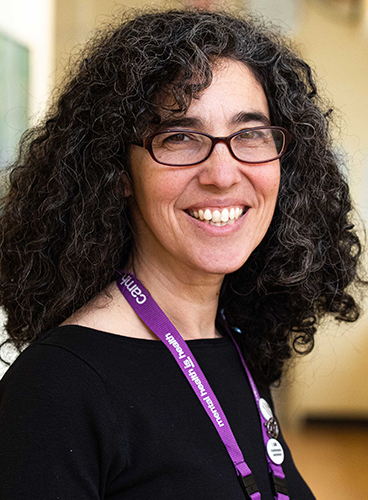
By Katherine O’Brien
Unless Ash Sharma feels safe with his health care provider, he is not going to be able to allow any kind of assessment or treatment. In his case, a sense of connection is not just a nice thing to share with his clinician, it is the essential first step in the delivery of care.
Which explains why late last year, his sister — Dr. Saroo Sharda — found herself overwhelmed with gratitude when a dental team built enough time into their appointment schedule to allow them to communicate and collaborate with Mr. Sharma about his teeth cleaning.
“Both my mom and I were in tears when we thanked them after my brother’s [dental] procedure because, in our experience, that type of care has, unfortunately, been the exception rather than the rule.”
The Sharma family has long experienced trepidation in bringing Mr. Sharma, who has an intellectual and developmental disability (IDD), to a health care appointment. His fear manifests in extreme agitation, making it difficult to perform procedures on him.
At times, as a child, he was held down to have bloodwork taken, remembers his sister. It’s experiences such as these that likely instilled in him a lifelong fear of medical visits, she says. Dental visits are also trying for her brother, now 50. In fact, before the family found this new dentist, Mr. Sharma had been too agitated to undergo a proper dental cleaning for five years.
“Somebody putting a gloved hand into his mouth is very nerve-wracking for him. It takes a lot of time and a lot of effort and a lot of compassion to really get to a point where the dentist can even examine him,” says Dr. Sharda. Sadly, not all health care professionals are willing to take the extra time that patients like Mr. Sharma need to feel comfortable in a clinical setting. Before finding his new dentist, he had gone to another clinic where he refused to open his mouth for an examination out of fear. The dental technician, exasperated by his behaviour, refused to call the dentist to come in and meet him.
Dr. Sharda’s perspective, as a sibling of a person with IDD, has made her particularly aware of how little accommodation the health care system makes for patients like her brother.
In general, Dr. Sharda says, health care practitioners tend not to look closely at how people with disabilities have been affected by trauma experienced in the medical system. “I see people coming into the operating room who are labeled as difficult, when really what they are feeling is very unsafe,” says Dr. Sharda who is an anesthesiologist, Associate Dean, Equity and Inclusion for the Faculty of Health Sciences at McMaster University, and Equity, Diversity and Inclusion lead at CPSO.
“Everybody deserves that kind of compassionate care, where we really are attuned to what the person in front of us might need”
Many people with IDD carry significant burdens of trauma that can have a hugely negative impact on their well-being, says Dr. William F. Sullivan, who has more than 20 years of experience researching and working with patients with IDD in Ontario. He says this trauma can affect the ability of people with IDD to cope with a range of adverse life experiences. Although the diagnosis, “existential trauma,” is not in the DSM-5, any patient with IDD is at risk for this condition, he says, adding that doctors who adopt a trauma-informed approach can help avoid triggering past traumas in these patients. Dr. Sullivan recently assumed the Joseph P. Kennedy Senior Chair in Bioethics at the Kennedy Institute of Ethics in Washington, DC, a role that promotes the clinical-ethical health care of people with IDD.
In her work as an anesthesiologist, Dr. Sharda integrates a trauma-informed approach. During the pre-operative assessment, she tries to find out what specific fears, if any, a patient has around the process. “I try to ascertain, what is the thing or things that are making this experience potentially traumatic for this person, and how many of those things can we change and mitigate.” If they are afraid of having a mask on their face, for instance, she will explore options, such as letting them hold the mask themselves. She will also advocate for patients to have their caregivers in the operating room for induction of general anesthesia and in the recovery room when they wake up, even though this may be challenging to operationalize, especially in an overstretched system and, sometimes, in the context of various hospital policies.
“Sometimes in medicine and in hospitals, especially, we need to understand and frame policy and procedure in context — it cannot be enforced at the expense of humanity and common sense,” she says. “It's actually going to help us in the operating room if we have music on and let them hold the mask and allow the familiar and safe presence of a caregiver. I think it's having conversations and being creative and saying, ‘Look, this works better for everybody, especially for the patients, but also for us.’”
Dr. Sharda thinks the problem is, at least in part, systemic. She speaks of a medical model that encourages health care practitioners to prioritize efficiency before all else. She understands the angst of running behind when a waiting room is packed, or the concern that a patient’s surgery may be postponed because of delays in the surgery schedule; still, she believes “we really have to move as a system, and, as physicians, to thinking about truly patient-centred care.”
“I try to ascertain, what is the thing or things that are making this experience potentially traumatic for this person, and how many of those things can we change and mitigate.”
In her view, doctors need to focus on what the patient needs. Although physicians may be limited in what can be done for each patient, “what you can do is … be kind, you can be empathetic. It sounds so obvious, but so often we lose that — and kindness can go such a long way. I mean, if that dental technician had just said, ‘I’m so sorry that this is difficult for you. Is there anything we can do to make this easier?’ The outcome may have been exactly the same … but the kindness would have made a huge difference.”
Indeed, Mr. Sharma has had health care practitioners who have shown him kindness. When he was reluctant to get an endoscopy because he was frightened about the IV line, one of his sister’s colleagues took the time to talk him through it, looking at different ways she could get the IV in.
“Everybody deserves that kind of compassionate care, where we really are attuned to what the person in front of us might need,” says Dr. Sharda. “And by attuned, I don't mean that we should automatically know, I mean that we should be willing to ask — and we should be willing to listen.”
Like Dr. Sharda, Dr. Yona Lunsky believes that tuning into patients is crucial. Dr. Lunsky, whose research has included teaching mindfulness to people with disabilities and caregivers, believes that cultivating mindfulness may also help doctors be more effective in providing care to patients with IDD. Noticing a patient’s body language and how they’re communicating, observing their interactions with their family or support workers, and taking cues from them is so important, she says.

“I think being aware of what we’re experiencing ourselves and what they’re experiencing can sometimes change the pace of a conversation. And being mindful or present to a person’s experience helps you see what is stressful in that moment for that person, so that you’re more able to pause and adapt or modify your own approach,” says Dr. Lunsky, Director of CAMH’s Azrieli Adult Neurodevelopmental Centre in Toronto, a research centre dedicated to improving care for adults with neurodevelopmental disabilities and mental health challenges.
Dr. Lunsky, who grew up with a sister with a developmental disability, says not only have many people with such disabilities experienced trauma, but many have been stigmatized their whole lives and face barriers in many areas, such as education, housing and employment, in addition to health care. According to population-based research from ICES, adults with IDD are more likely to have repeat emergency visits and hospitalizations, be designated as Alternative Level of Care (ALC) once in hospital and are nearly four times as likely to die prematurely.
Change in attitudes needed
There are national guidelines and clinical tools to support health care providers in managing health issues for these patients. Putting the guidance into practice, however, appears to remain a challenge — many patients and their families continue to report negative experiences when it comes to the provision of their health care, says Dr. Lunsky.
One important element in providing care to people with disabilities involves a change in attitudes. Dr. Lunsky points to a 2021 survey of 714 practising U.S. physicians in which 82.4 percent of respondents reported that people with significant disability have worse quality of life than people without a disability, and only 56.5 percent strongly agreed that they welcome patients with disability into their practices.
“Ableism is one piece of what’s going on,” says Dr. Lunsky. She also notes that in some cases, the only time a doctor is exposed to someone with disabilities is when they are hospitalized or in the emergency department, “when they’re at their utmost worst.” This, too, might shape their attitude to this population, she reflects.
Ableism may not be the only bias that some people with IDD face, points out Dr. Sharda. She refers to the concept of intersectionality, which sees people as being disadvantaged by multiple sources of oppression, including race, class, gender identity, sexual orientation, religion and other identity markers. For instance, she says, people with developmental disabilities who are racialized tend to fare worse in the health care system than those who are not.
“We all carry bias, and we often carry bias towards people who are not neurotypical because that's ingrained in us through society,” says Dr. Sharda. We need to acknowledge that those biases are reflections of the bigger systems of oppression that exist in our culture and in our society, she adds.
Dr. Sharda encourages physicians to give thoughtful consideration to their perceptions, judgments, behaviour, decisions and actions to better understand the biases that may be shaping them.












